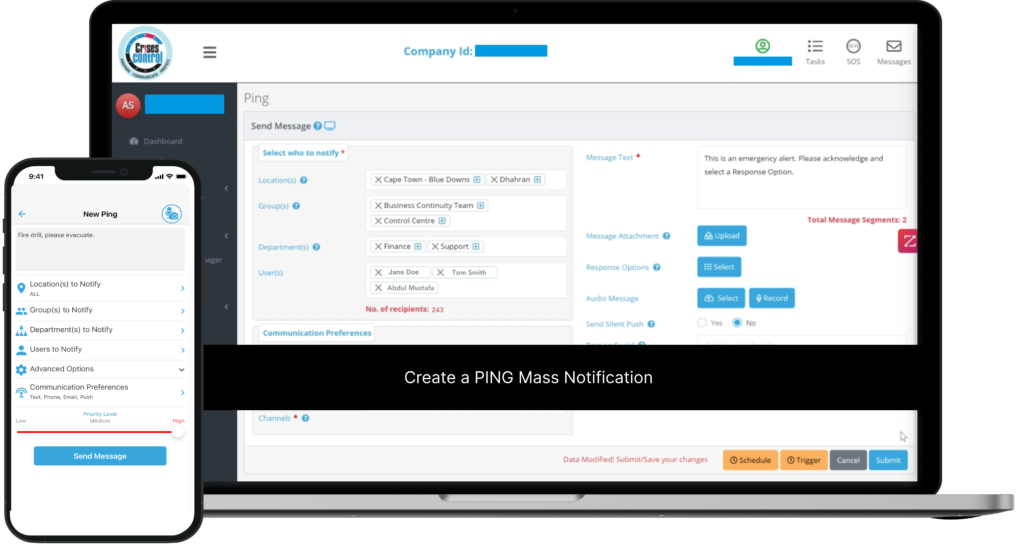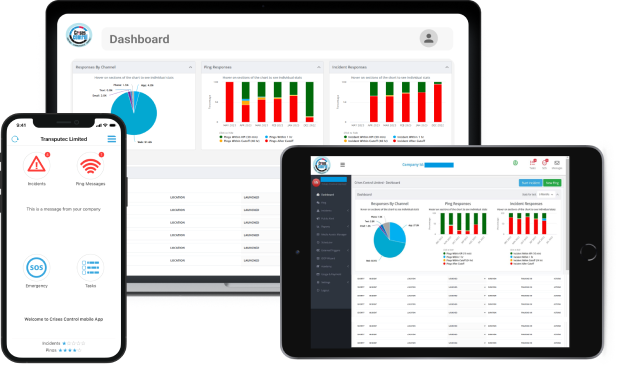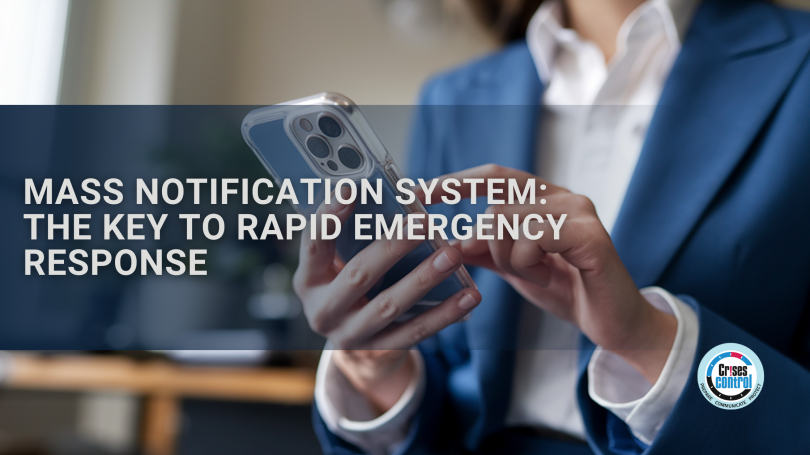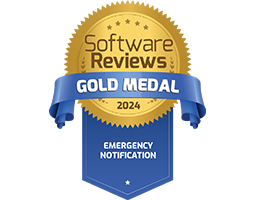Written by Anneri Fourie | Crises Control Executive
Imagine this: A fire breaks out in your office building. Employees on the upper floors are unaware, security teams scramble for information, and evacuation efforts are delayed. The result? Confusion, panic, and potential harm.
Now, imagine a different scenario. Within seconds, an automated alert reaches every employee via SMS, email, mobile push notifications, and phone calls. The message provides clear instructions on safe exits, assembly points, and next steps. Employees acknowledge receipt, allowing management to track who is safe and who may need assistance.
This is the power of a Mass Notification System. In a crisis, every second counts, and the ability to instantly reach the right people can mean the difference between a well-managed response and a disaster.
However, not all mass notification systems are created equal. Many organisations still rely on outdated communication methods that are slow, unreliable, or lack real-time tracking. This blog explores why a modern Mass Notification System is essential, what features to look for, and how Crises Control ensures your organisation is always prepared.
Why Every Organisation Needs a Mass Notification System
Emergencies are unpredictable, but your response should never be. Many organisations still rely on outdated communication tools, assuming they will be effective when a crisis strikes. However, this approach leaves gaps in speed, reach, and coordination. Here’s why traditional methods fall short:
1. Delayed Communication
Phone trees, emails, and manual alert systems take far too long to reach everyone. In emergencies, a delay of even a few minutes can escalate a situation beyond control.
2. Limited Reach
Many employees may not be in front of their emails or near their phones when an emergency occurs. Without multi-channel alerts, crucial messages may go unseen.
3. No Confirmation or Response Tracking
Sending a message isn’t enough, you need to know if people received it, understood it, and acted on it. Traditional communication methods lack real-time acknowledgment tracking.
4. Uncoordinated Crisis Response
Without a structured system, different teams may receive conflicting information, delaying emergency response. A Mass Notification System ensures that all stakeholders receive the same, clear instructions.
A modern Mass Notification System eliminates these issues by delivering instant, automated, and targeted alerts to key personnel, ensuring a coordinated emergency response.
What Makes an Effective Mass Notification System?
Not all systems are built the same. To be truly effective, a Mass Notification System should have the following features:
1. Multi-Channel Alerts: Ensuring No One Misses the Message
During a crisis, relying on a single communication channel, like email, is risky. A robust system should send alerts via:
- SMS and push notifications for instant mobile alerts
- Emails for detailed instructions and follow-ups
- Voice calls for urgent, verbal updates
- Desktop pop-ups for employees at their workstations
- Public address systems for on-site notifications
This ensures that employees receive alerts regardless of where they are or what device they are using.
2. Location-Based Alerts: Targeting the Right People
A geo-targeting feature allows organisations to send alerts based on employee locations. This is especially useful for:
- Multi-site companies managing different office locations
- Remote workers who need region-specific updates
- On-the-move employees, such as logistics teams or field workers
By tailoring messages to specific locations, businesses avoid unnecessary panic while ensuring those directly affected receive the most relevant information.
3. Two-Way Communication: Enabling a Real-Time Response
A Mass Notification System should not be a one-way broadcast tool. Employees should be able to:
- Acknowledge alerts to confirm they have received and understood them
- Request assistance if they are in danger or need help
- Report incidents directly through the system
This two-way functionality allows organisations to track response rates and adjust crisis strategies in real time.
4. Automated Incident Response: Reducing Human Error
During high-pressure situations, manual processes can lead to mistakes. Automated workflows ensure that:
- Alerts are sent to the right people instantly
- Incident response teams are notified based on severity
- Tasks are assigned automatically to the appropriate personnel
By reducing human error, organisations save time and ensure consistency in their crisis response.
5. Integration with Incident and Business Continuity Management Software
A Mass Notification System is most effective when integrated with:
- Incident Management Software: Automatically triggers alerts and tracks response efforts
- Business Continuity Management Software: Ensures emergency plans are executed smoothly
- Compliance and reporting tools: Keeps records for audits and post-incident reviews
Without integration, emergency response remains fragmented and inefficient.
Interested in our Ping Mass Notification Software?
Efficiently alert everyone in seconds at scale with our Mass Notification Software – PING, get the message out fast and ensure rapid response and recovery.

How a Mass Notification System Improves Incident Management
A Mass Notification System plays a crucial role in emergency response by enabling:
1. Faster Crisis Containment
- Alerts instantly mobilise response teams
- Clear instructions prevent panic and misinformation
2. Coordinated Emergency Response
- Predefined workflows ensure that the right people are alerted at the right time
- Task management tools help teams stay on track
3. Improved Business Continuity
- Faster communication reduces operational downtime
- Compliance with industry regulations avoids legal and financial penalties
How Crises Control Ensures Reliable Emergency Communication
Crises Control offers a powerful, cloud-based Mass Notification System that helps organisations respond to crises with speed and precision.
1. Instant Multi-Channel Alerts
Crises Control’s Ping Mass Notification System delivers alerts across SMS, push notifications, voice calls, and emails, ensuring no message is missed.
2. Real-Time Incident Management
With Crises Control’s Incident Management Software, organisations can:
- Automate incident escalation
- Track response actions and assign tasks
- Use dashboards to monitor incidents in real time
3. SOS Panic Button for Employee Safety
Employees can trigger an SOS Panic Button to send distress signals with their exact location, enabling faster rescue efforts.
4. Cloud-Based Resilience for 24/7 Availability
Crises Control runs on its own cloud infrastructure, ensuring your system remains operational even if other platforms go down.
5. Compliance and Audit Reporting
The system logs all communications, making it easy to:
- Generate audit reports
- Maintain regulatory compliance
- Analyse response efficiency
Real-World Example: How a Global Law Firm Enhanced Communication with a Mass Notification System
A leading global law firm faced challenges in maintaining clear and efficient communication across its international offices. By implementing Crises Control’s Mass Notification System, the firm was able to:
- Instantly notify employees across multiple locations about critical updates
- Send geo-targeted alerts to ensure only relevant employees received key messages
- Enable two-way communication for immediate responses and confirmations
- Maintain full compliance with legal and regulatory requirements through automatic audit logs
The result? Faster response times, improved employee safety, and enhanced regulatory compliance across all jurisdictions.
Conclusion: Strengthen Your Emergency Response with Crises Control
A Mass Notification System is no longer a nice-to-have, it is a critical tool for protecting employees, minimising disruptions, and ensuring business resilience.
With Crises Control, you can:
- Send instant, multi-channel alerts
- Automate incident response workflows
- Enhance business continuity and compliance
- Ensure 24/7 availability with resilient cloud hosting
Don’t leave your crisis communication to chance. Contact us today for a free personalised demo and see how Crises Control can transform your emergency response strategy.
Request a FREE Demo








